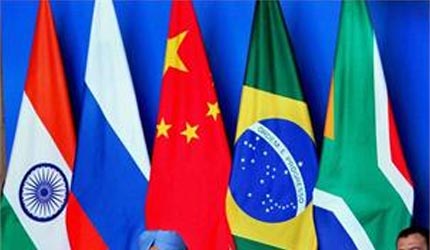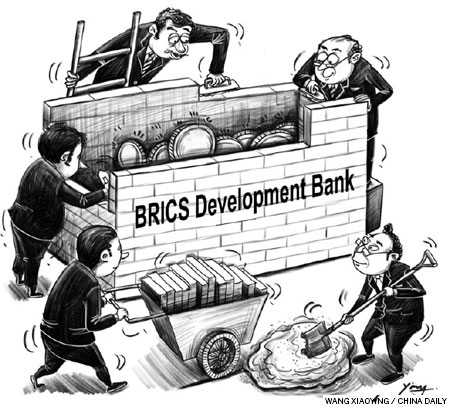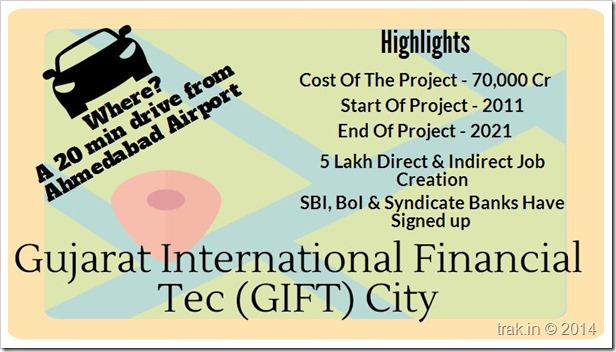After the BRICS
summit on 15 July in Fortaleza, the Brazilians had organized a meeting
for the BRICS leaders with the Presidents of South America on 16 July in Brasilia. This is an
imaginative idea by the Brazilians to bridge their regional leadership with
their BRICS alliance.
It was perhaps the
first time that an Indian Prime Minister will get an opportunity to meet South
American leaders together. In the last two decades, South American leaders have
started pursuing a more autonomous and assertive foreign policy with a strong belief
in a multipolar world and multilateralism
They have freed themselves from the
stigma of being called the "backyard of United States." This is
evident from their success in thwarting the US proposal to form a hemispheric
Free Trade Area of the Americas. They have preferred to become collectively
strong through UNASUR (South American Union). In this context, the South
American leaders, will welcome Modi's proactive role in global affairs and will
look forward to working with India.
What makes INDIA special for the South
American Region ?
 |
- South America is emerging as a contributor to
India's energy and food security. Venezuela, Brazil, Ecuador and Colombia
have started supplying crude oil regularly.While there is growing
gap between India's domestic production and demand, South America has the
potential to increase its oil production and exports in the future.
- India has been importing more than a billion
dollars' worth of soy and sunflower oil from Brazil and Argentina annually.
It has also been importing over 2 billion dollars' worth minerals (copper
is the main item) from South America which has rich mineral resources.
- On the other hand, the South American
political and business leaders view India as a new, large and growing
market for their exports. Conscious of the perils of overdependence on
China, they are keen to diversify and cultivate India as a trade
partner.
- Argentina learnt this lesson when China
imposed a ban on imports of Argentine soy oil in 2010 to express their
displeasure with Argentina on some other issue. Argentina, the world's
largest exporter of soy oil, was shocked since China was till then the
largest importer of Argentine soy oil. Argentina was relieved and grateful
when India came to its rescue by doubling its imports of soy oil in that
difficult year.
- The South American governments and consumers
are happy with Indian pharmaceutical companies which have helped them to
reduce their cost of health care with low-cost generic medicines.
- The South Americans also appreciate the fact
that the Indian IT companies in the region provide jobs and training for
their young people.
- In Bolivia, Jindal Steel & Power initiated a $2.3 billion investment in the iron ore mine El Mutún, the biggest foreign direct investment project in Bolivian history, and the biggest of any Indian company in Latin America.
- In 2002, TCS, the largest Indian IT company, established a Global Delivery Center in Montevideo that put Uruguay on the global IT map. TCS employs 900 Uruguayans and is one of the largest and most valued employers in the country. Meanwhile, the Brazilian giant Embraer has sold planes in India, and Chile’s exports to India increased tenfold to $2.2 billion from 2003 to 2007. The two Indian IT companies operating in Chile—TCS and Evalueserve—employ more than 2,000 people.
- In total, some
35,000 Latin Americans work for Indian companies in the region today—more
than half in IT, business process outsourcing and knowledge process
outsourcing.
What should India do to furthur make the relationship strong ?
- As South America is emerging as a significant
trade partner, India should deepen and widen the Preferential Trade
Agreement with Chile and Mercosur and consider upgrading them to FTAs and
also sign FTAs with Colombia and Peru, the second and third largest
destinations of India's exports to South America.
- India should increase Lines of Credit to South
American countries and sign the Double Taxation Avoidance Agreements with
major countries to facilitate investment and trade.
Apart from ECONOMICS ?
- In the early twentieth century,
Bengali poet Rabindranath Tagore’s verses influenced Chilean poet Pablo
Neruda.
- Argentine cultural impresario
Victoria Ocampo took the Indian writer under her wing, hosting him for two
months in Buenos Aires in 1924–1925 and publishing his work in her
magazine Sur.
- Mexican writer Octavio Paz, who
was posted to New Delhi as a young diplomat in the 1950s and returned as
an ambassador in the 1960s, was impressed by the depth and breadth of
Indian civilization. In the 1990s, he even published a memoir of his time
there, Vislumbres de la India.
- Neruda visited India four times.
In Madras, he was impressed by Indian women and their saris, wrapped
“around the body with supernatural grace, covering them in a single flame
as shining silk.” But he had a falling out with Prime Minister Jawaharlal
Nehru, who in 1951 left him waiting for a long time before receiving him,
and penned one of his darkest and most ominous poems, “India 1951.”
Miscellaneous !!!
ITEC programme:
The Indian Technical and Economic
Cooperation (ITEC) Programme was started by Indian Government as a bilateral programme
of assistance. Various scholarships
are given to students from South
America under ITEC to incorporate their youth with latest technical knowledge
& help in nation building.









